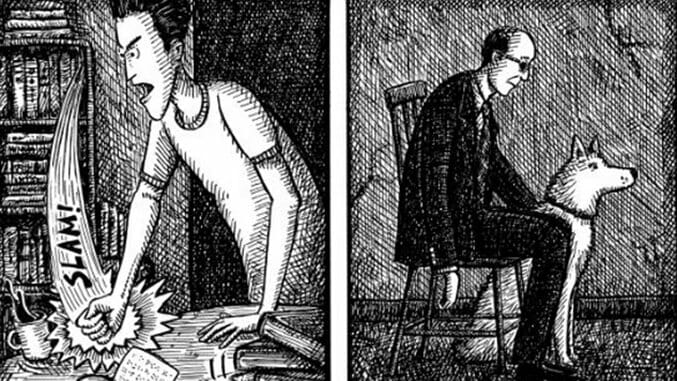First Second Exclusive: David Carlson and Landis Blair Announce The Hunting Accident, A Crime Family Drama

Writer David Carlson and artist Landis Blair’s upcoming graphic novel, The Hunting Accident, encompasses everything from the true-crime history of Chicago to weightier philosophical concerns. It’s based on the life of Matt Rizzo, a man blinded as a result of a robbery, who found himself sharing a cell with Nathan Leopold, Jr. (as in the notorious early 20th-century murderers “Leopold and Loeb”). Leopold began teaching Rizzo about literature; after his release, the reformed Rizzo started a family and told them that his blindness was the result of a hunting accident, leading to complications years later. This graphic novel diagrams the relationship between Rizzo and his son, Charlie, and the truths and compassion that come with discovering a father’s sins.
The book was initially funded through Kickstarter, and will be released by First Second in 2017. Paste talked with Carlson about the origins of the project and excavating the history of Chicago.![]()
Paste: Where did you first encounter the story of Matt Rizzo, and what about it drew you in as a storyteller?
David Carlson: I was out for breakfast with my friend Charlie and he started telling me about his father Matt Rizzo. As a lifelong Chicagoan, I had heard about the Leopold [and] Loeb murder that was known as the Crime of the Century. It was fascinating enough that Charlie’s dad was Leopold’s cellmate in Stateville prison. But the more Charlie talked, the further my jaw dropped. His father was 22-years-old, no education, newly blind and suicidal. I couldn’t imagine a darker place than that 8×12-foot prison cell. So I think what drew me in was the fact in his darkest moment, the tiniest bit of light that came to him, was through the darkest criminal in the entire country at that time in history, a thrill-killer named Nathan Leopold.
Paste: Your artistic background encompasses everything from opera to film. What made comics the right medium for you to use to tell this story?
Carlson: I had read comics as a kid and I was curious about the potential of graphic novels. They were on my radar but I had never actually read one. A friend recommended Maus and the relationship between words and pictures took on a whole new perspective for me. I continued down that path and after I read Feynman, I got excited about the potential for a content-rich story. I had written a screenplay and the form was limiting. Rightly so. In a movie, the viewer is at the mercy of the editor who controls the pacing. To my delight, I realized that the reader controls the pacing by the page turn. Landis and I spent a good deal of time thinking through the issues of pacing and directing the eye of the reader.

The Hunting Accident Interior Art by Landis Blair
Paste: Was this the first piece of Chicago-related history that you’ve sought to explore through art?
Carlson: That’s an interesting question. I first met Charlie Rizzo when he joined the board of a non-profit street opera company I co-founded. Opera-Matic is focused on place-making and one of the things we do is organize community events that celebrate in music and song the history of the Chicago neighborhood where we’re located. It’s great to see people develop a greater sense of home when they know the rich history of their streets.
Paste: You’ve written a little about your research process for the book. How extensive of an archive is there in and around Chicago about the milieu around when this book is set?
Carlson: The writings of Matt Rizzo are housed in the archives of the Newberry Library in Chicago. And of course Charlie has been a huge resource of information. We spent about six months talking about his father’s life. I also read a book Charlie gave me called The Jack-Roller. It was written by a sociologist [Clifford Shaw] in 1930 and it describes very clearly the milieu Matt grew up in on the west side of Chicago. The Leopold [and] Loeb trial happens to be one of the most documented murders in history. In 1924, newspapers were booming and reporters came to Chicago from all over the world to report about these two wealthy, educated young men who had kidnapped and murdered a 14-year-old boy in an effort to prove they could commit the perfect crime. They had been reading Nietzsche and thought they could prove to be his Ubermensch (Superman). As details came out about the two boys’ sex-for-crime pact, the salacious nature of their relationship brought worldwide attention. There were six alienists (precursor to psychologists) that examined them as part of the trial record. Three for the defense and three for the prosecution. Northwestern University houses a massive archive that includes the entire transcript of the trial. The Chicago History Museum houses an extensive collection of Leopold’s personal artifacts. Everything from the glasses he dropped at the crime scene to boxes stuffed with personal correspondence and handwritten notebooks detailing his language studies during his 33 years in prison.
-

-

-

-

-

-

-

-

-

-

-

-

-

-

-

-

-

-

-

-

-

-

-

-

-

-

-

-

-

-

-

-

-

-

-

-

-

-

-

-











































